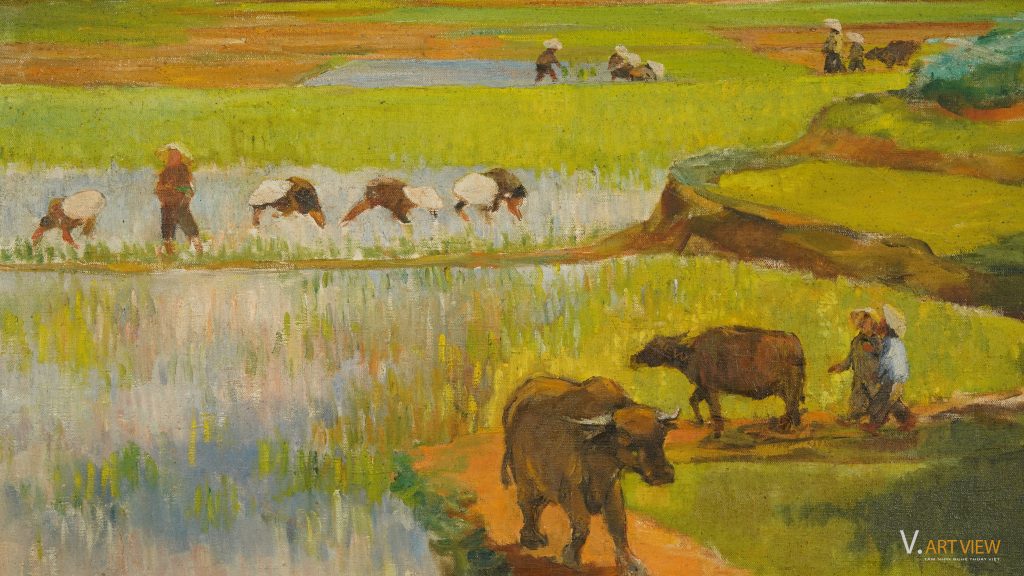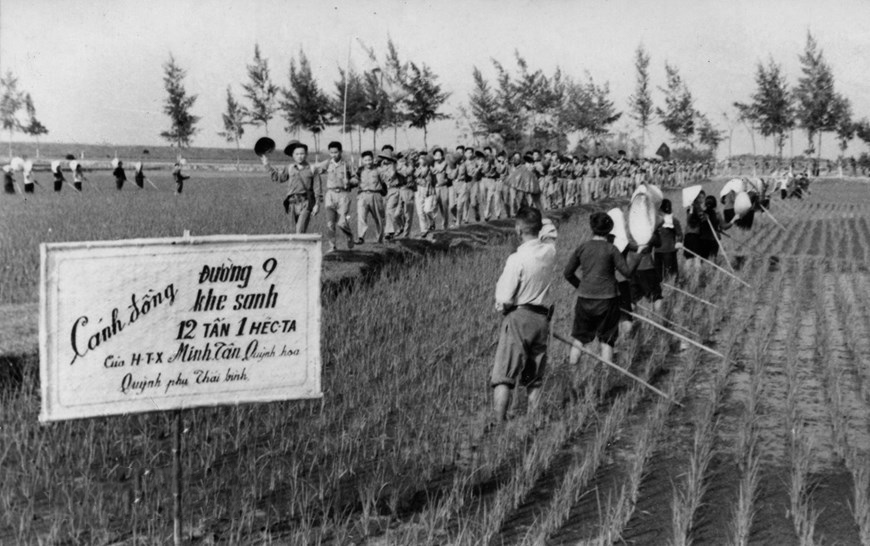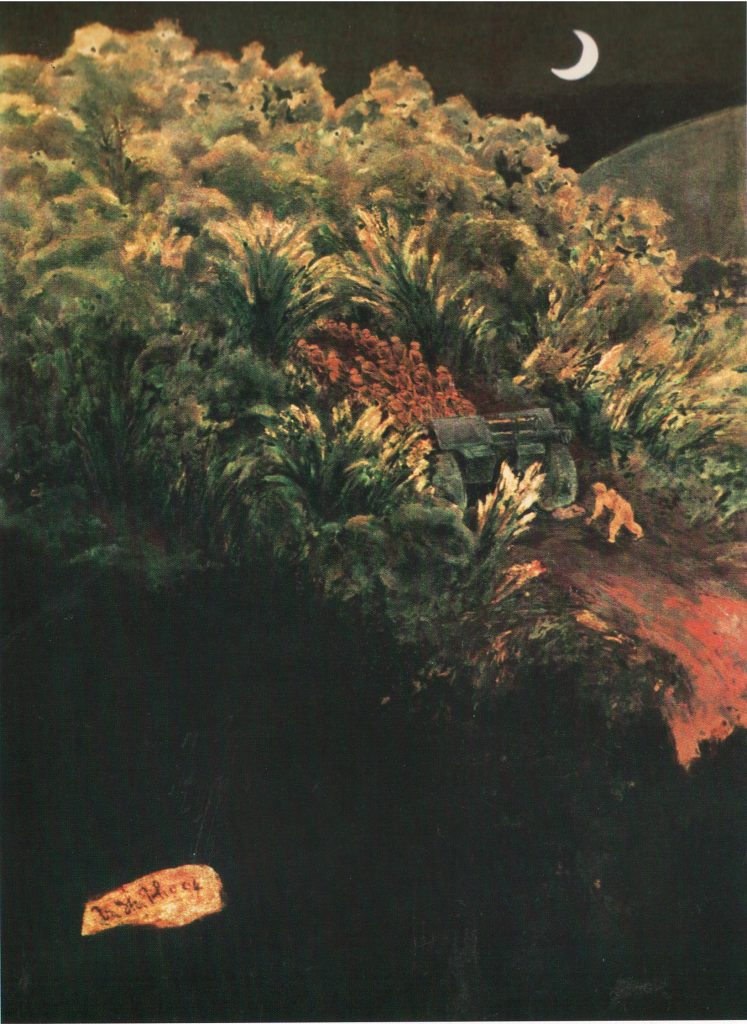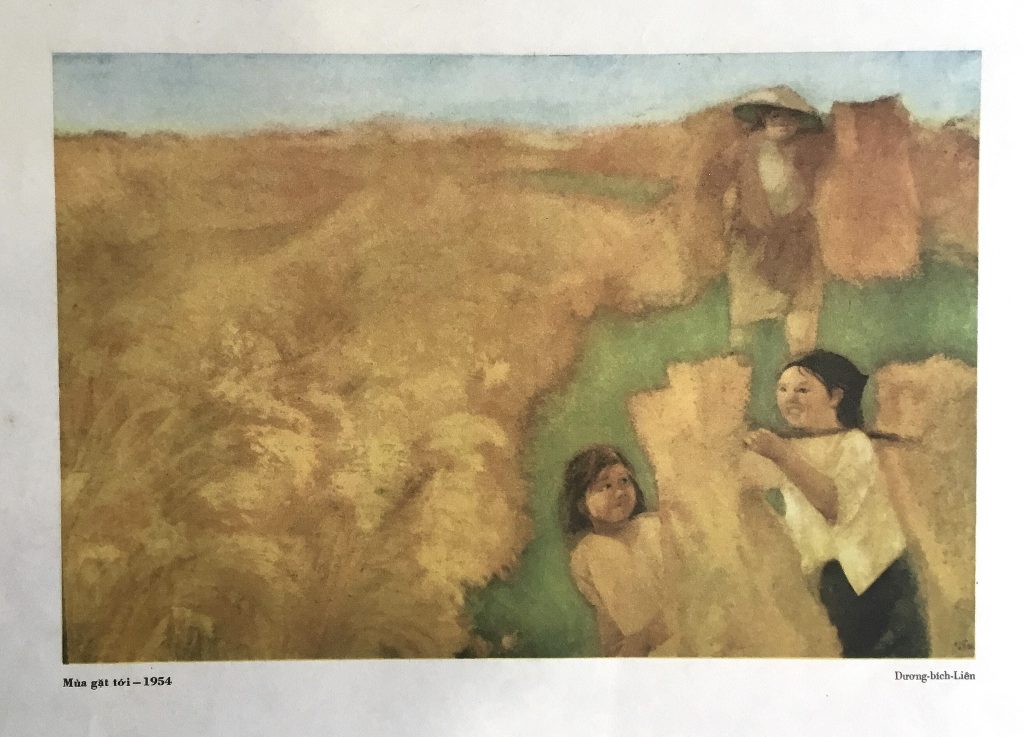TRẦN ĐÌNH THỌ (1919-2011). New rice season of homeland. 1972. Oil. 73×86 cm. Nguyễn Minh collection, Hà Nội
From a landscape painting…
“New rice season of homeland” by painter Trần Đình Thọ was created in 1972. According to political experts, 1972 was the most fierce historical moment in the Vietnam War; especially the US air strike against North Vietnam. According to the estimates of both sides, the damage numbers are very huge…
Thus, the battlefield is boiling fiercely, but why did this painting describe such a peaceful northern rural scene?
In fact, if only looking at the content, the human details, the scene shown on the surface of the painting, the above opinion is reasonable. But, this is the work of painter Trần Đình Thọ. A person who experienced many roles in fine arts management.
At that time, he held many important positions in Vietnam fine arts. Principal of Vietnam College of Fine Arts (1966-1984) now Vietnam University of Fine Arts; Vice President of Art Research Institute. Editor-in-Chief of the Journal of Art Research (1969-1979); Acting Director of the Institute of Fine Arts and Fine Crafts (1969-1972) is now the Vietnam Fine Arts Museum.
From a political perspective, he must be someone who was deeply imbued with the Party’s policies. Therefore, his works are not only about nature, landscapes, and people but in terms of the creative state must be at a much higher level of thinking.
The awareness of the national revolution from a very early time…
Tiền Phong Newspaper, No. 6, February 16, 1946, published the article “Tết paintings in the early days of independence” by artist Trần Đình Thọ. “Vietnamese art today also wants to serve and work for the survival of the nation, rather than being neutral towards life, only worshiping beauty. All the titles of the paintings are the titles of the struggle…”

Portrait of artist Trần Đình Thọ (1919-2011)
This shows that the revolutionary consciousness, the sense of peaceful and prosperous nationalism formed in the soul of young painter Trần Đình Thọ very early.
Painter Trần Đình Thọ was born in 1919 in Hưng Yên. He graduated from the 13th class of Indochina Fine Arts College (1939-1944) with Nguyễn Sỹ Ngọc, Nguyễn Trọng Hợp, Phạm Văn Đôn, Huỳnh Văn Thuận… Like other patriotic artists, even before the August Revolution he soon participated in the activities of the Association for the Propagation of the National Language and the Cultural Association for National Salvation.
He is one of the typical painters of socialist realism. His art discreetly combines lyricism, personal narrative, deep and passionate love for his homeland.
The strength of national solidarity
In “New rice season of homeland”, painter Trần Đình Thọ conveyed many deep feelings.
We see the northern countryside fields with layers of landscape. Farmers are planting rice, a few buffaloes are leisurely walking on the red dirt road after plowing; in the distance is blue mountain of Ba Vì standing against the sky with white clouds floating… all are present on the cool green background of bamboo, trees, grass, young rice… A peaceful picture in rural North Vietnam, 1972.

TRẦN ĐÌNH THỌ (1919-2011). New rice season of homeland. 1972. Oil. 73×86 cm. Nguyễn Minh collection, Hà Nội
Contrasting with that scene was the South entering the fierce phase of the war against America to save the country.
How do these two contrasting images relate with each other?
In fact, very relevant…
History has recorded, after World War II, the war to invade Vietnam from 1954 to 1975 was America’s largest, longest, fiercest, most costly war. During those difficult years, under the leadership of the Party; The State and the entire people formed a unity. All reinforced the front line. The whole North “emulates production”. Movements such as “Three ready” youth, “Three brave” women, “One hand with plow one hand with gun” farmers, “One hand with hammer one hand with gun” workers, students did “Thousands of good deeds against the US”; civil servants also carried out many exciting emulation movements such as “High Productivity Saturday”, “Practice for Competition”…

Youth movement Three ready of Thái Bình, August 1964. Source: Vietnam News Agency
In particular, Thái Bình province recorded 5 tons of rice, marking the historical milestone of rice productivity in the North. Thái Bình’s slogan “Exuberant rice, outstanding army” encouraged the people’s spirit of labor emulation, production, fighting, driving out the American imperialists, gained independence and freedom, and unify the country.
That spirit, that atmosphere spreaded throughout the North. Everyone’s heart was towards the beloved South. The more difficult the situation is, the more sacred the beauty of labor becomes, bearing noble human values, a symbol of the strength, intelligence and soul of the Vietnamese nation.
Deep memories
Viet Art View talked to Ms Trần Tuyết Mai, the oldest daughter of painter Trần Đình Thọ. She shared: “At that time, around 1970-1972, the Southern battlefield was extremely fierce. In the North, city people had to evacuate to the countryside. This painting was created by her father at the evacuation site in Tam Nông, Phú Thọ.

TRẦN ĐÌNH THỌ (1919-2011). The apple tree. 1965. Oil. 34×46 cm
In the professional world, painter Trần Đình Thọ is famous with the nickname “Thọ bamboo”, with nuances of bamboo shaping; left a special mark on his works. Like many painters of the new revolutionary era, he paid special attention to the theme of revolutionary war, socialist construction, labor, new countryside… The poetic and lyrical quality of the artist was always hidden discreetly and delicately in the way of expression. The image of bamboo is present in ‘Out to the field’, lacquer, 1961, 58×88 cm; ‘Night Marching’, lacquer, 1974, 120×160 cm; ‘Protecting the village’, lacquer, 1980; two paintings ‘Bamboo’, lacquer, 1991; ‘Sunset’, lacquer, 1994, 43×64 cm; ‘Pulling artillery’, lacquer, 1994; ‘Morning’, silk, 1989… with many different nuances of bamboo; left a special mark on his works.

TRẦN ĐÌNH THỌ (1919-2011). Pulling the artillery. 1994. Lacquer. 90×60 cm
In “Pulling artillery”, lacquer, 1994; viewers can feel a moonlit night at the beginning of the month, shining softly on the trees, row on row of mountains, illuminating the image of a soldier inserting artillery. So poetic, so peaceful, it seems like there’s no war…
“New rice season of homeland” is the same. We don’t see bombs and bullets, only farmers planting rice in peaceful fields. But really in it are passionate hearts, speeding up the production of good crops, turned into food and transported to the beloved South, contributing to the fight against America. The attitude, the position, the enthusiasm to work are expressed in a hidden, delicate way in the work of an artist imbued with revolutionary thought like painter Trần Đình Thọ; just like President Hồ once wrote: “Culture and art are also a front. You are soldiers on that front.”
Through many hardships, Vietnam has not stopped developing, growing stronger. Because “Our people have a passionate patriotism. It’s one of our precious traditions. From the past to the present, every time the Fatherland was invaded, that spirit was vibrant, it formed an extremely powerful and huge wave, it surmounted all dangers and difficulties…” (excerpt from the Politics Report of Uncle Hồ at the Second Congress, February 1951 of the Party).








